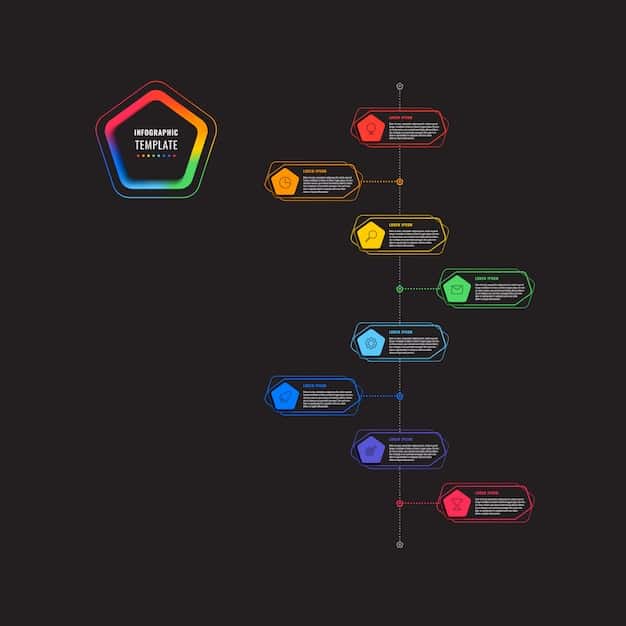PCI Compliance Costs: Budgeting for US E-commerce in 2025

PCI compliance costs for US e-commerce businesses in 2025 include assessment fees, remediation expenses, technology upgrades, and ongoing monitoring, but strategic budgeting and proactive security measures can minimize these expenses.
Navigating the landscape of PCI Compliance Costs: Budgeting and Minimizing Expenses for US E-commerce Businesses in 2025 can seem daunting. But with a clear strategy and proactive approach, you can manage and even minimize these expenses.
Understanding PCI DSS Requirements for E-commerce
The Payment Card Industry Data Security Standard (PCI DSS) is a set of security standards designed to protect cardholder data. For e-commerce businesses in the US, understanding these requirements is the first step in managing compliance costs.
PCI DSS applies to any organization that stores, processes, or transmits cardholder data. This includes e-commerce merchants, payment processors, and service providers. Compliance is essential for maintaining trust with customers and avoiding severe penalties for data breaches.
Key PCI DSS Requirements
The PCI DSS outlines 12 main requirements, grouped into six control objectives:
- Build and Maintain a Secure Network and Systems
- Protect Cardholder Data
- Maintain a Vulnerability Management Program
- Implement Strong Access Control Measures
- Regularly Monitor and Test Networks
- Maintain an Information Security Policy

Each of these requirements has specific sub-requirements that businesses must adhere to. Understanding these details is crucial for effective budgeting and cost management.
Failing to comply with PCI DSS can lead to fines, increased transaction fees, legal liabilities, and damage to your brand reputation. Therefore, it’s in every e-commerce business’s best interest to prioritize PCI compliance.
Calculating the Direct Costs of PCI Compliance
Direct costs are those that are explicitly tied to achieving and maintaining PCI compliance. These can be categorized into several areas, each contributing to the overall expense.
Let’s break down these key cost categories to help you understand where your money is going.
Assessment Fees
- Self-Assessment Questionnaires (SAQ): If your business qualifies, you can complete an SAQ, which typically involves internal resources and time.
- Qualified Security Assessor (QSA) Audits: Larger businesses or those with complex setups may require a QSA audit, which can be costly but provides a thorough assessment.
- Approved Scanning Vendor (ASV) Scans: Regular vulnerability scans by an ASV are often required to identify security weaknesses in your systems.
Remediation Expenses
Remediation involves fixing any security gaps identified during the assessment process. This can include:
- Software and Hardware Upgrades: Updating outdated systems and implementing new security tools.
- Security Patches: Applying the latest security patches to prevent exploits.
- Network Configuration Changes: Adjusting network settings to enhance security.
Technology and Security Solutions
Implementing and maintaining security solutions is a major part of PCI compliance. Key solutions include:
- Firewalls: Protecting your network from unauthorized access.
- Intrusion Detection/Prevention Systems (IDS/IPS): Monitoring and blocking malicious activity.
- Encryption Tools: Encrypting cardholder data both in transit and at rest.
Indirect Costs and Hidden Expenses
Beyond the direct costs, there are indirect costs that can significantly impact your budget. These are often less visible but can add up over time.
Being aware of these hidden expenses can help you better plan and manage your overall PCI compliance budget.
Employee Training
Training employees on security awareness and PCI DSS requirements is crucial. This includes:
- Initial Training Programs: Educating employees on PCI DSS principles and their role in maintaining compliance.
- Ongoing Training and Updates: Keeping employees informed about new threats and best practices.
Documentation and Policy Management
Maintaining detailed documentation and up-to-date security policies is essential. This involves:
- Creating and Updating Policies: Developing and regularly reviewing security policies and procedures.
- Maintaining Documentation: Keeping records of all compliance activities, assessments, and remediation efforts.
Lost Productivity
The time spent on compliance activities can sometimes detract from other business operations. Minimize this by:
- Streamlining Processes: Optimizing compliance tasks to reduce time spent.
- Automating Tasks: Using automation tools to handle repetitive compliance activities.

Indirect costs can be substantial, but with careful planning and efficient processes, you can minimize their impact on your budget.
Strategies for Minimizing PCI Compliance Costs
Minimizing PCI compliance costs requires a strategic approach that considers both short-term and long-term financial implications. Proactive measures and efficient processes can lead to significant savings.
Let’s explore some effective strategies for keeping your compliance expenses in check.
Scope Reduction
Reducing the scope of your PCI DSS assessment can significantly lower costs. This involves:
- Outsourcing Sensitive Data Handling: Using third-party payment processors to handle cardholder data.
- Tokenization: Replacing sensitive data with non-sensitive tokens.
Leveraging Technology
Utilizing technology can streamline compliance efforts and reduce manual tasks. Consider:
- Compliance Automation Tools: Tools that automate tasks like vulnerability scanning and policy enforcement.
- Cloud-Based Solutions: Cloud services with built-in security features.
Implementing Strong Security Practices
Adopting robust security practices can prevent breaches and reduce the need for costly remediation. This includes:
- Regular Security Assessments: Identifying and addressing vulnerabilities before they can be exploited.
- Security Awareness Training: Educating employees to recognize and avoid phishing and other threats.
By implementing these strategies, you can proactively manage and minimize your PCI compliance costs, while still maintaining a high level of security.
Budgeting Best Practices for PCI Compliance in 2025
Creating a detailed budget is essential for managing PCI compliance costs effectively. A well-planned budget helps you allocate resources, track expenses, and identify potential areas for savings.
Here are some best practices for budgeting for PCI compliance in 2025.
Conduct a Risk Assessment
Start by conducting a thorough risk assessment to identify potential vulnerabilities and compliance gaps. This will help you prioritize your spending and allocate resources effectively.
Prioritize Security Measures
Focus on implementing the most critical security measures first. This ensures that you are addressing the most significant risks to your cardholder data.
Regularly Review and Update Your Budget
PCI compliance requirements and security threats are constantly evolving. Regularly review and update your budget to reflect these changes.
Effective budgeting requires careful planning, ongoing monitoring, and a commitment to continuous improvement.
Future Trends in PCI Compliance and Cost Implications
The landscape of PCI compliance is continually evolving, with new technologies and security threats emerging regularly. Understanding these trends can help you prepare for future cost implications.
Let’s take a look at some key trends and their potential impact on your compliance budget.
Increased Focus on Cloud Security
With more businesses moving to the cloud, there is an increased focus on cloud security. This means:
- Adapting Security Measures: Implementing security controls that are specific to cloud environments.
- Choosing Secure Cloud Providers: Selecting cloud providers with robust security certifications.
Emerging Technologies and PCI DSS
Emerging technologies like blockchain and artificial intelligence (AI) are also impacting PCI DSS. Businesses need to:
- Understand New Requirements: Keeping up with PCI DSS guidance on emerging technologies.
- Implement Appropriate Security Controls: Adapting security measures to address new risks introduced by these technologies.
The Role of AI and Automation
AI and automation can play a significant role in streamlining PCI compliance. This includes:
- Automated Vulnerability Scanning: Using AI-powered tools to detect and remediate vulnerabilities.
- Predictive Threat Detection: Leveraging AI to identify and prevent potential security breaches.
Staying informed about these trends and adapting your compliance strategy accordingly can help you manage costs and maintain a strong security posture.
| Key Point | Brief Description |
|---|---|
| 💰 Budgeting | Plan and allocate resources for PCI compliance. |
| 🛡️ Security | Implement strong security practices continuously. |
| ☁️ Cloud | Secure cloud environments and providers. |
| 🤖 Automation | Automate tasks with AI tools for efficiency. |
Frequently Asked Questions
▼
PCI DSS compliance is adhering to the Payment Card Industry Data Security Standard to protect cardholder data. It involves implementing security measures and processes to prevent fraud and data breaches.
▼
PCI compliance is vital for maintaining customer trust, avoiding fines and legal liabilities, and safeguarding your brand reputation by preventing data breaches and ensuring secure transactions.
▼
The main costs include assessment fees, remediation expenses, technology upgrades, employee training, and documentation. Indirect costs also involve lost productivity and policy management.
▼
You can minimize costs by reducing scope, leveraging technology, implementing strong security practices, and conducting regular security assessments and employee training to prevent breaches.
▼
Stay informed about the increased focus on cloud security, the impact of emerging technologies, and the role of AI and automation in streamlining compliance efforts to manage future compliance costs.
Conclusion
Managing PCI compliance costs for your e-commerce business requires a comprehensive understanding of the requirements, strategic budgeting, and proactive security measures. By implementing the strategies and best practices discussed, you can minimize expenses, maintain a strong security posture, and protect your customers’ data. Staying informed and adapting to future trends will ensure your business remains compliant and secure in the ever-evolving digital landscape.





